light Peugeot Partner Tepee 2015 Owner's Manual
[x] Cancel search | Manufacturer: PEUGEOT, Model Year: 2015, Model line: Partner Tepee, Model: Peugeot Partner Tepee 2015Pages: 276, PDF Size: 12.76 MB
Page 4 of 276

2
Partner_2_VP_en_Chap00a_Sommaire_ed02-2014
Key 18
Alarm 20
Doors
21tailgate
23
Rear roof flap
26
Central locking
27
Instrument panel
28
Adjusting the time
29
W
arning lamps
30
Fuel gauge
38
Coolant
38
Under-inflation detection
39
Service indicator
41
Lighting dimmer
42
Steering
wheel adjustment
43
Manual gearbox
43g
ear shift indicator
44
6-speed electronic
gearbox
45
Stop & Start
47
Starting and stopping
50
Hill start assist
51Lighting control
52
wipers 55
Cruise control
57
Speed limiter
60
Heating /
Air conditioning
manual
63 digital
65
Demisting and defrosting
6
7
Front seats
69
Rear bench seat
71
Rear seats
(5 seat version)
74
Rear seats
(7 seat version)
77
Modularity
84
Front fittings
86
Zenith roof
90
Roof bars
95
Courtesy lamps
96
Load space cover
(5 seat version)
97
Load space cover
(7 seat version)
101
Mirrors
103e
lectric windows
105
READY
TO SET OFF
3.
18-51 SAFETY
5.
106-134
Locatione
xterior 5
Interior
6
Instruments and controls
8technical data - Maintenance
12
Instruments and controls Left hand drive
13
Right hand drive
14
OVERVIEW
1.
4-14
Hazard warning lamps 106
Parking brake 106
Parking sensors
107
Anti-lock braking system (ABS)
109
e
mergency braking assistance
109
ASR and DSC
1
10
g
rip control
1
11
Seat belts
1
13
Airbags
1
16
Child seats
120
Deactivating the passenger's
front airbag
1
23
Recommended seats
126
Installation
128
ISOFIX seats
132
Child lock
134
EASE OF USE and
COMFORT
4.
52-105
2.
15-17
ECO-DRIVING
environment 15
Eco-driving 16
t
he "Visual Search " (visual
index) section assists
you in finding the controls
and functions and their
associated page numbers
on the schematic outlines of
the vehicle.
Contents
Page 10 of 276
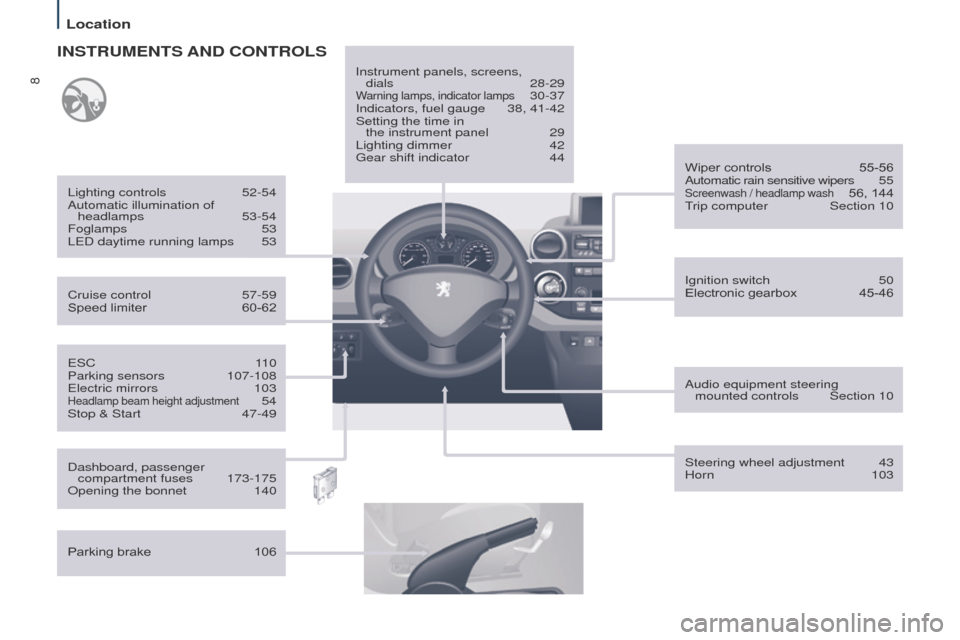
8
Partner_2_VP_en_Chap01_vue-ensemble_ed02-2014
eSC 110
Parking sensors 107-108e
lectric mirrors
103Headlamp beam height adjustment 54
Stop & Start
47-49
Cruise control
57-59
Speed limiter
60-62
Lighting controls
52-54
Automatic illumination of headlamps
53-54
Foglamps
53
L
e
D daytime running lamps
53
INSTRUMENTS AND CONTROLS
Dashboard, passenger
compartment fuses 173-175
Opening the bonnet
140
Parking brake
106 Instrument panels, screens,
dials 28-29
Warning lamps, indicator lamps 30-37
Indicators, fuel gauge
38, 41-42
Setting the time in
the instrument panel
29
Lighting dimmer
42g
ear shift indicator
44
Ignition switch
50
Electronic gearbox
45-46
Wiper controls
55-56
Automatic rain sensitive wipers
5
5
Screenwash / headlamp wash 56, 144trip computer
Section 10
Audio equipment steering mounted controls
Section 10
Steering wheel adjustment
43
Horn
103
Location
Page 12 of 276
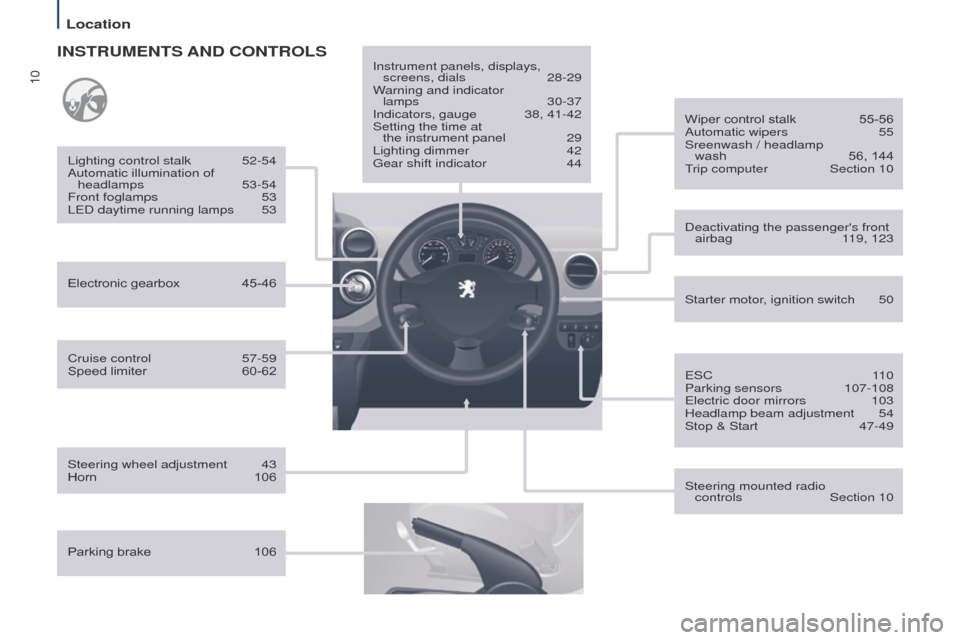
10
Partner_2_VP_en_Chap01_vue-ensemble_ed02-2014
Cruise control 57-59
Speed limiter 60-62
Lighting control stalk
52-54
Automatic illumination of headlamps
53-54
Front foglamps
53
L
e D daytime running lamps
53
INSTRUMENTS AND CONTROLS
Parking brake 106Instrument panels, displays,
screens, dials
28-29
W
arning and indicator
lamps
30-37
Indicators, gauge
38, 41-42
Setting the time at
the instrument panel
29
Lighting dimmer
42g
ear shift indicator
44
Steering wheel adjustment
43
Horn
106 Starter motor
, ignition switch
50
Wiper control stalk
55-56
Automatic wipers
55
Sreenwash / headlamp
wash
56, 144trip computer
Section 10
Steering mounted radio
controls
Section 10
Deactivating the passenger's front
airbag
1
19, 123
e
SC
1
10
Parking sensors
107-108e
lectric door mirrors
103
Headlamp beam adjustment
54
Stop & Start
47-49
Electronic gearbox
45-46
Location
Page 14 of 276
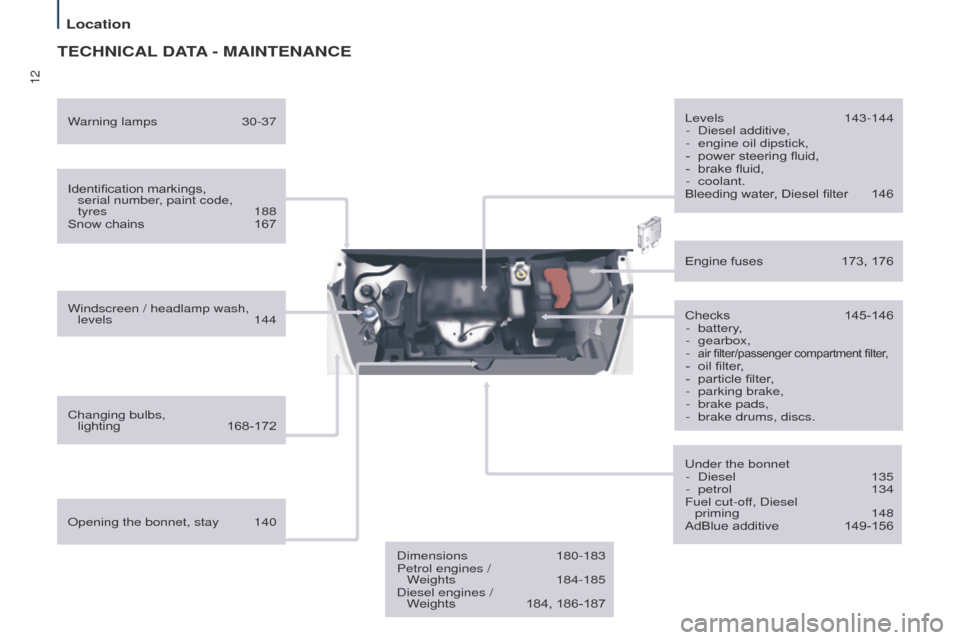
12
Partner_2_VP_en_Chap01_vue-ensemble_ed02-2014
TECHNICAL DATA - MAINTENANCE
Identification markings, serial number, paint code,
tyres
188
Snow chains
167
Windscreen / headlamp wash, levels
144
Changing bulbs,
lighting
168-172 Checks
145-146
-
battery
,
-
gearbox,
-
air filter/passenger compartment filter,- oil filter,
- particle filter ,
-
parking brake,
-
brake pads,
-
brake drums, discs.
Engine fuses
173, 176
Opening the bonnet, stay
140 Levels
143-144
-
Diesel additive,
-
engine oil dipstick,
-
power steering fluid,
-
brake fluid,
-
coolant.
Bleeding water
, Diesel filter
146
W
arning lamps
30-37
u
nder the bonnet
-
Diesel
135
-
petrol
134
Fuel cut-of
f, Diesel
priming
148
AdBlue additive
149-156
Dimensions
180-183
Petrol engines / Weights
184-185
Diesel engines / Weights
184, 186-187
Location
Page 15 of 276
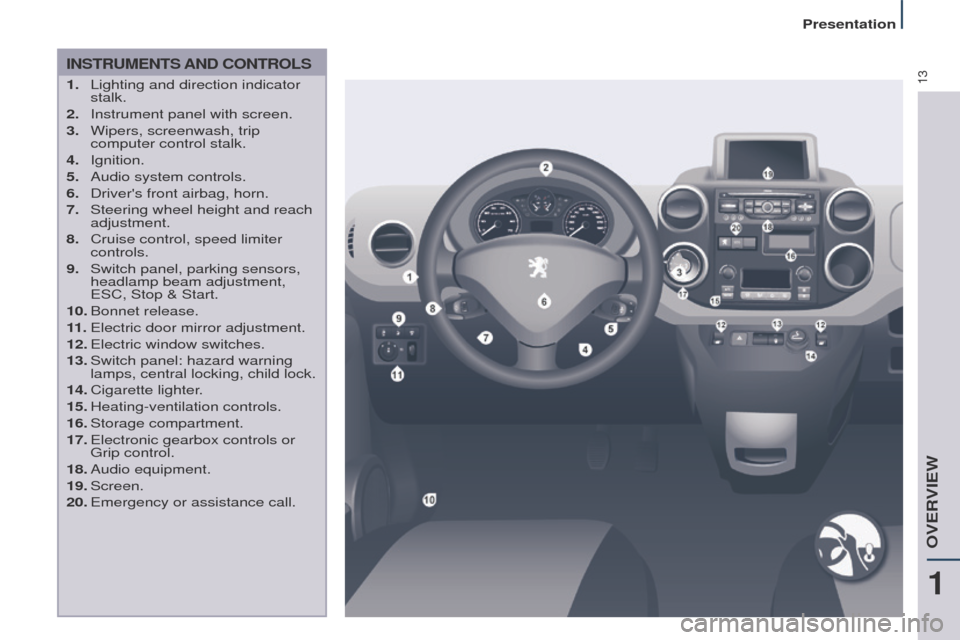
13
Partner_2_VP_en_Chap01_vue-ensemble_ed02-2014
INSTRUMENTS AND CONTROLS
1. Lighting and direction indicator
stalk.
2.
Instrument panel with screen.
3.
Wipers, screenwash, trip
computer control stalk.
4.
Ignition.
5.
Audio system controls.
6.
Driver's front airbag, horn.
7.
Steering wheel height and reach
adjustment.
8.
Cruise control, speed limiter
controls.
9.
Switch panel, parking sensors,
headlamp beam adjustment,
e
SC, Stop & Start.
10.
Bonnet
release.
11 .
e lectric door mirror adjustment.
12.
e lectric window switches.
13.
Switch panel: hazard warning
lamps, central locking, child lock.
14.
Cigarette
lighter.
15.
Heating-ventilation
controls.
16.
Storage
compartment.
17.
e lectronic gearbox controls or
g
rip control.
18.
Audio
equipment.
19.
Screen.
20.
e mergency or assistance call.
1
OVeRVIeW
Presentation
Page 16 of 276
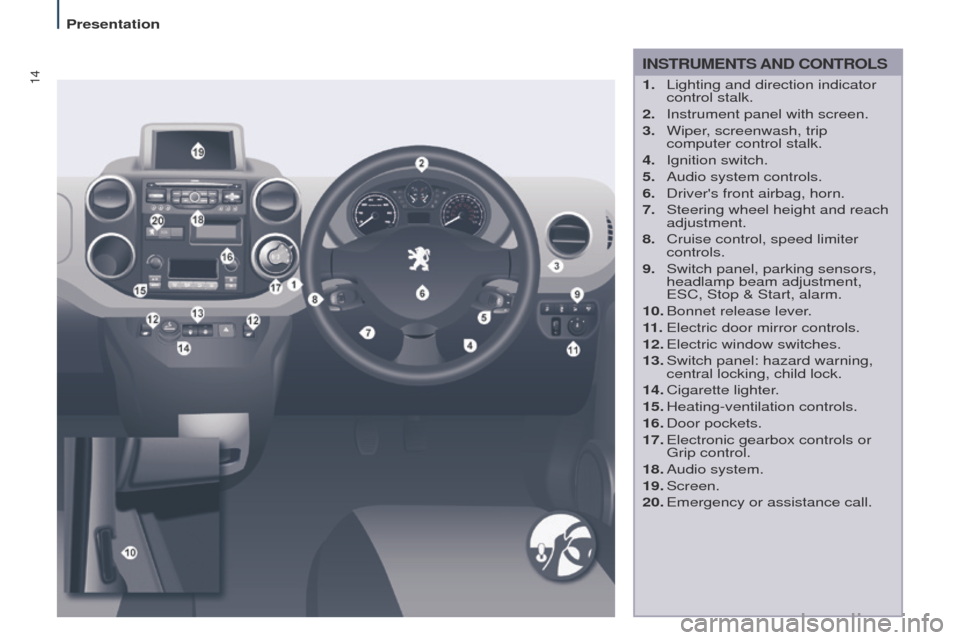
14
Partner_2_VP_en_Chap01_vue-ensemble_ed02-2014
INSTRUMENTS AND CONTROLS
1. Lighting and direction indicator
control stalk.
2.
Instrument panel with screen.
3.
Wiper
, screenwash, trip
computer control stalk.
4.
Ignition switch.
5.
Audio system controls.
6.
Driver's front airbag, horn.
7.
Steering wheel height and reach
adjustment.
8.
Cruise control, speed limiter
controls.
9.
Switch panel, parking sensors,
headlamp beam adjustment,
e
SC, Stop & Start, alarm.
10.
Bonnet release lever
.
11 .
e lectric door mirror controls.
12.
e lectric window switches.
13.
Switch panel: hazard warning,
central locking, child lock.
14.
Cigarette
lighter.
15.
Heating-ventilation
controls.
16.
Door
pockets.
17.
e lectronic gearbox controls or
g
rip control.
18.
Audio
system.
19.
Screen.
20.
e mergency or assistance call.
Presentation
Page 18 of 276

16eco-driving is a range of everyday practices that allow the motorist to o\
ptimise their fuel consumption and CO2
emissions.
Eco-driving
Optimise the use of your gearbox
With a manual gearbox, move off gently and change up
without waiting. During acceleration change up early.
With an automatic or electronic gearbox, give preference
to automatic mode and avoid pressing the accelerator
pedal heavily or suddenly.
t
he gear shift indicator invites you engage the most
suitable gear: as soon as the indication is displayed in the
instrument panel, follow it straight away.
For vehicles fitted with an electronic or automatic gearbox,
this indicator appears only in manual mode.
Drive smoothly
Maintain a safe distance between vehicles, use engine
braking rather than the brake pedal, and press the
accelerator progressively.
t
hese practices contribute
towards a reduction in fuel consumption and CO
2
emissions and also helps reduce the background traffic
noise.
If your vehicle has cruise control, make use of the system
at speeds above 25 mph (40 km/h) when the traffic is
flowing well.
Control the use of your electrical equipment
Before moving off, if the passenger compartment is too
warm, ventilate it by opening the windows and air vents
before using the air conditioning.
Above 30 mph (50 km/h), close the windows and leave the
air vents open.
Remember to make use of equipment that can help keep
the temperature in the passenger compartment down
(sunroof and window blinds...).
Switch off the air conditioning, unless it has automatic
regulation, as soon as the desired temperature is attained.
Switch off the demisting and defrosting controls, if not
automatic.
Switch off the heated seat as soon as possible.
Switch off the headlamps and front foglamps when the
level of light does not require their use.
Avoid running the engine before moving off, particularly in
winter; your vehicle will warm up much faster while driving.
As a passenger, if you avoid connecting your multimedia
devices (film, music, video game...), you will contribute
towards limiting the consumption of electrical energy, and
so of fuel.
Disconnect your portable devices before leaving the
vehicle.
Motoring & environment
Page 20 of 276
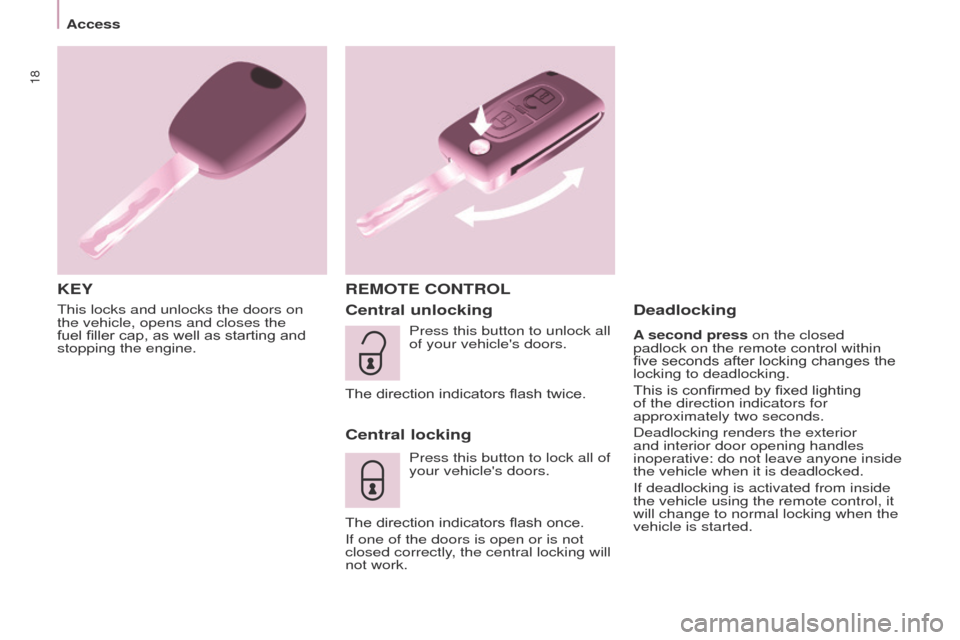
18
Partner_2_VP_en_Chap03_Pret-a-partir_ed02-2014
this locks and unlocks the doors on
the vehicle, opens and closes the
fuel filler cap, as well as starting and
stopping the engine.
KEY REMOTE CONTROL
Central unlocking
Central locking
Press this button to lock all of
your vehicle's doors.
The direction indicators flash once.
If one of the doors is open or is not
closed correctly, the central locking will
not work.
Deadlocking
A second press on the closed
padlock on the remote control within
five seconds after locking changes the
locking to deadlocking.
This is confirmed by fixed lighting
of the direction indicators for
approximately two seconds.
Deadlocking renders the exterior
and interior door opening handles
inoperative: do not leave anyone inside
the vehicle when it is deadlocked.
If deadlocking is activated from inside
the vehicle using the remote control, it
will change to normal locking when the
vehicle is started.
Press this button to unlock all
of your vehicle's doors.
The direction indicators flash twice.
Access
Page 30 of 276

28
Partner_2_VP_en_Chap03_Pret-a-partir_ed02-2014
Dials
1. Distance recorder in kilometres /
miles.
2.
Screen.
3.
Fuel level, coolant temperature.
4.
Rev counter
.
5.
t
rip distance recorder / service
indicator zero reset.
6.
Instrument panel lighting dimmer
.
Level 2 display screen
INSTRUMENT PANEL
Level 1 display screen
Displays
- Speed limiter / Cruise control.
-
Kilometres / Miles travelled.
-
Service indicator
, total kilometres /
miles.
-
Presence of water in the Diesel
filter
.
-
Diesel pre-heating.
Screens
the format of the information
presented in the screen depends on
the vehicle's equipment.
Instruments and controls
Page 33 of 276
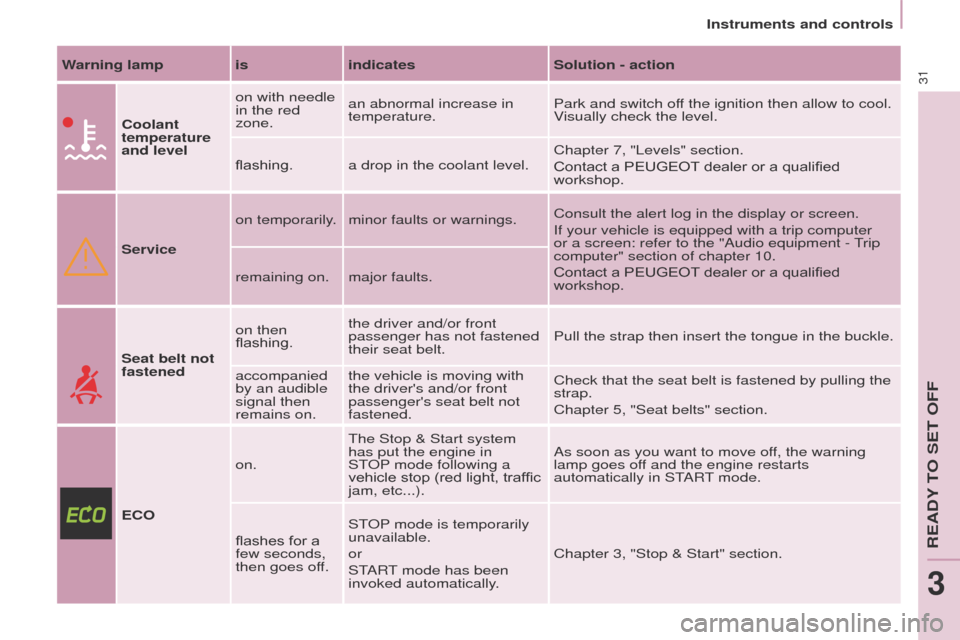
31
Partner_2_VP_en_Chap03_Pret-a-partir_ed02-2014
Warning lamp isindicatesSolution - action
Coolant
temperature
and level on with needle
in the red
zone.
an abnormal increase in
temperature.
Park and switch off the ignition then allow to cool.
Visually check the level.
flashing. a drop in the coolant level. Chapter 7, "Levels" section.
Contact a PEUGEOT
dealer or a qualified
workshop.
Service on temporarily. minor faults or warnings.
Consult the alert log in the display or screen.
If your vehicle is equipped with a trip computer
or a screen: refer to the "Audio equipment -
trip
computer" section of chapter 10.
Contact a PEUGEOT
dealer or a qualified
workshop.
remaining on. major faults.
Seat belt not
fastened on then
flashing.
the driver and/or front
passenger has not fastened
their seat belt.
Pull the strap then insert the tongue in the buckle.
accompanied
by an audible
signal then
remains on. the vehicle is moving with
the driver's and/or front
passenger's seat belt not
fastened.
Check that the seat belt is fastened by pulling the
strap.
Chapter 5, "Seat belts" section.
ECO on.
t
he Stop & Start system
has put the engine in
S
t
OP
mode following a
vehicle stop (red light, traffic
jam,
etc...).As soon as you want to move off, the warning
lamp goes off and the engine restarts
automatically in S
t
ARt mode.
flashes for a
few seconds,
then goes of
f.S
t
OP
mode is temporarily
unavailable.
or
S
t
ARt mode has been
invoked automatically
.Chapter 3, "Stop & Start" section.
Instruments and controls
ReADY tO Set OFF
3